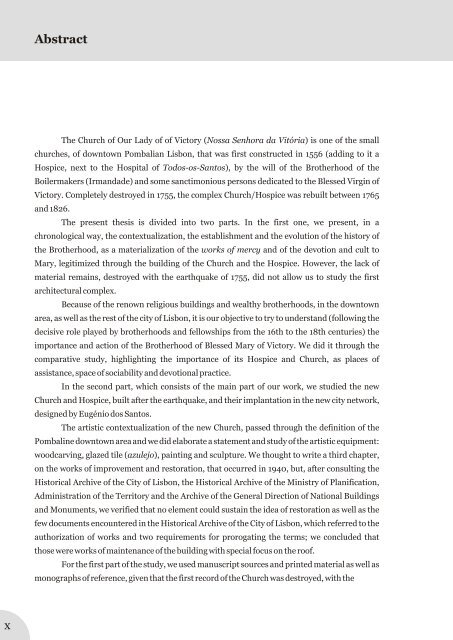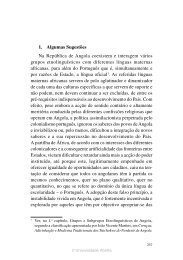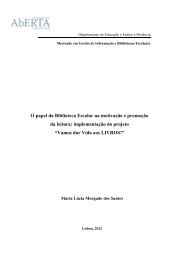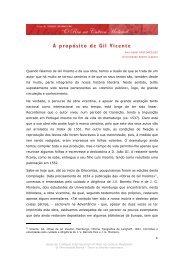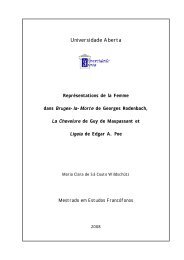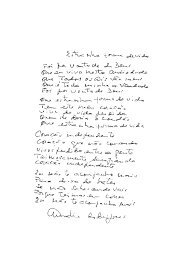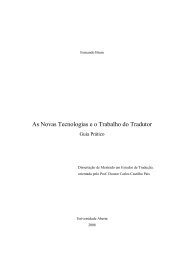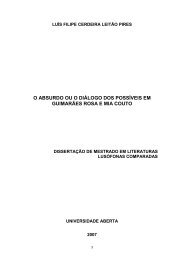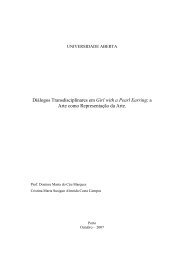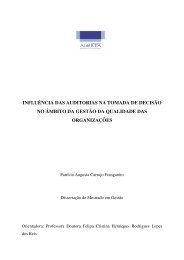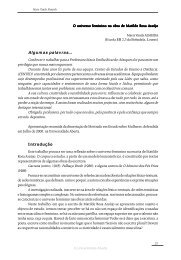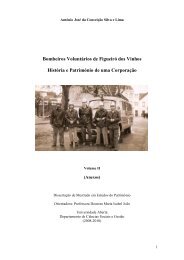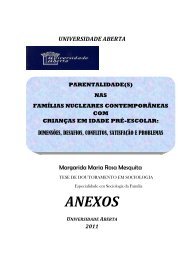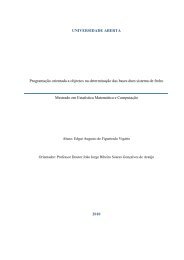- Page 1: Arminda Mendes Rodrigues A Igreja d
- Page 4: iv ÍNDICE GERAL A Igreja de Nossa
- Page 7 and 8: Agradecimentos Este trabalho de dis
- Page 9: Para a primeira parte deste estudo,
- Page 13 and 14: Lors de la première partie de l'é
- Page 15 and 16: Todos estes elementos permitiram a
- Page 18 and 19: 18 Parte I Irmandades e confrarias:
- Page 20 and 21: 20 Pressionada pela Reforma Protest
- Page 22 and 23: 22 Sensivelmente, a partir de meado
- Page 24 and 25: 24 No entanto, a Coroa aproveitaria
- Page 27 and 28: 2. A Irmandade de Nossa Senhora da
- Page 29: A prática era comum a este tipo de
- Page 32 and 33: 32 instituição revela uma nova me
- Page 34 and 35: 34 Quanto ao santo patrono, este n
- Page 36 and 37: 36 Tornando-se uma instituição ec
- Page 38 and 39: 38 No século XVII, frei Nicolau de
- Page 40 and 41: 40 O facto de não ter consultado f
- Page 42 and 43: 42 Tal como surgem sempre referenci
- Page 44 and 45: 44 79 O culto de Nossa Senhora da V
- Page 46 and 47: 46 No final da Idade Média nota-se
- Page 49 and 50: 3. A sobrevivência da irmandade: O
- Page 51 and 52: Mais ainda, em 1787, o Papa Pio VI
- Page 53 and 54: Quadro 2 Bens Móveis: Foros, Renda
- Page 55 and 56: Pede também, neste acto público,
- Page 57 and 58: Situação polémica, a substituiç
- Page 59: tradicionais geridas pela Igreja, c
- Page 62 and 63:
62 Da transcrição e comparação
- Page 64 and 65:
64 dos ornamentos e alfaias litúrg
- Page 66:
66 Seguem-se as excepções às com
- Page 71 and 72:
1. A nova Lisboa A Baixa pombalina
- Page 73 and 74:
Na planificação da cidade e na es
- Page 75 and 76:
porque alem de serem Engenheiros de
- Page 77 and 78:
1.2 - Eugénio dos Santos e Carlos
- Page 79 and 80:
Para além das fachadas de prédios
- Page 81 and 82:
1.3 - Pombal e o suporte legislativ
- Page 83 and 84:
Será no reinado de D. João V que,
- Page 85:
Esta legislação tenta contemplar
- Page 88 and 89:
88 Entre muitas recomendações “
- Page 90 and 91:
90 A subordinação a que foram suj
- Page 92:
92 “Daí as anomalias que se cons
- Page 95 and 96:
1.4.1 - Evolução Histórica dos E
- Page 97 and 98:
Nicolau. Reedificada no ano de 1717
- Page 99 and 100:
1.4.2 - Permanências na Baixa Pomb
- Page 101 and 102:
Freguesia Santa Maria Madalena Igre
- Page 103 and 104:
que os orientava no sentido nascent
- Page 105 and 106:
Começamos por dividi-las em quatro
- Page 107 and 108:
2. A reedificação 2.1 - A Campanh
- Page 109 and 110:
231 também descreve Eduardo Freire
- Page 111 and 112:
2.2 - O Processo de Reconstrução
- Page 113 and 114:
Pedia o rei que se distribuísse po
- Page 115 and 116:
Esperaram e decidiram aplicar as ve
- Page 117 and 118:
Recuando um pouco no tempo, poderem
- Page 119 and 120:
Como a obra já tinha sido começad
- Page 121 and 122:
2.3 - A Nova localização A envolv
- Page 123 and 124:
Podemos considerá-la “Igreja-pr
- Page 125 and 126:
2.4 - Planimetria e estrutura 2.4.1
- Page 127 and 128:
A leitura da planta e dos alçados
- Page 129 and 130:
Em toda a simplicidade repetitiva d
- Page 131 and 132:
2.4.2 - O interior Já no século X
- Page 133 and 134:
A NAVE A nave única, encontra-se c
- Page 135 and 136:
Na mesa do altar, correspondendo à
- Page 137 and 138:
SACRISTIA As sacristias, tal como s
- Page 139 and 140:
2.5 - Programa iconográfico: Os n
- Page 141 and 142:
Após o Concilio, a arte Sacra em P
- Page 143 and 144:
2.5.2 - O núcleo pictórico Podemo
- Page 145 and 146:
São Gregório Magno (Fig.77) repre
- Page 147 and 148:
Esta ideia é ainda reforçada pela
- Page 149 and 150:
2.5.3 - O núcleo retabular A parti
- Page 151 and 152:
2.5.4 - O núcleo escultórico Tal
- Page 153 and 154:
2.5.5 - O núcleo azulejar A produ
- Page 155 and 156:
Este ritmo só é quebrado pela dec
- Page 157 and 158:
Os atributos marianos escolhidos pa
- Page 159 and 160:
Conclusão O nosso trabalho sobre a
- Page 161 and 162:
a um dos mesários pela Irmandade,
- Page 163 and 164:
Cronologia Da Irmandade Igreja e Ho
- Page 165 and 166:
Bibliografia FONTES MANUSCRITAS IAN
- Page 167 and 168:
1853 - Carta da Mesa da Direcção
- Page 169 and 170:
Santo Agostinho R.S 021 São Gregó
- Page 171 and 172:
AA.VV., Lisboa Iluminista e o seu t
- Page 173 and 174:
BRITO, Mário Xavier, «Lisboa de O
- Page 175 and 176:
GOFF, Jacques, O Nascimento do Purg
- Page 177 and 178:
MONTES, José M.ª, El Libro de los
- Page 179 and 180:
SANTOS, Teresa Sequeira, A Igreja d
- Page 181 and 182:
Apêndice Documental
- Page 183 and 184:
Doc. 1 (A) Avaliação do estado da
- Page 185 and 186:
P. AV. Eminência lhes faça a mesm
- Page 187 and 188:
Doc.3 (A) Inventário de imagens, p
- Page 189 and 190:
fl. 2 vº 34$280 16.E Espaldar, e D
- Page 191 and 192:
39. Huma banquinha por feitio que s
- Page 193 and 194:
fl.6.v. 65. Duas placas mais piquen
- Page 195 and 196:
Doc.4 (B) Escriptura relativa à ob
- Page 197 and 198:
cumprir e guardar esta escriptura e
- Page 199 and 200:
Doc. 5 (A) Requerimento Ano: 1767,
- Page 201 and 202:
Espingardeiros e o Largo da Victori
- Page 203 and 204:
propriedades nem admetisse excepço
- Page 205 and 206:
fl.8vº Martins Louzado e pelo Sul
- Page 207 and 208:
EL Rey faço saber aos que este Alv
- Page 209 and 210:
Ruas: e que seja pago repartidament
- Page 211 and 212:
habitaçam dos artifices no plano d
- Page 213 and 214:
pertensé Belem a doze de Junho de
- Page 215 and 216:
fl.24 vº Nos cazos não esperados
- Page 217 and 218:
tem na Rua do Norte e as missas e s
- Page 219 and 220:
Portaria do Excelentissimo e Revere
- Page 221 and 222:
seguinte. Informe o Dezembargador I
- Page 223 and 224:
morador na Rua do Norte freguezia d
- Page 225 and 226:
desne (sic) o dia que a mesma Irman
- Page 227 and 228:
fl.43vº Reis e eu Paulo de Almeyda
- Page 229 and 230:
necessário e para as ditas missas
- Page 231 and 232:
fl.50 Padre Antonio Soares que ele
- Page 233 and 234:
lhe-há de esmola seis tostoens aco
- Page 235 and 236:
publica e obrigandosse todos os ben
- Page 237 and 238:
Alves vinte alqueires de trigo de f
- Page 239 and 240:
legados todos podera cobrar os rend
- Page 241 and 242:
fl.66vºo Testamento atras de Domin
- Page 243 and 244:
outrosim se mostrava estar a eles j
- Page 245 and 246:
fl.73 desta Cidade que dou fe passa
- Page 247 and 248:
Escrivão geral das Inspecoens que
- Page 249 and 250:
Doc.7 (A) Termo da acta da reunião
- Page 251 and 252:
madureza a verdadeira rezoluçaõ d
- Page 253 and 254:
fl.1vº Comquanto naõ fosse servid
- Page 255 and 256:
igualmente isto fezeram, relaxamos
- Page 257 and 258:
Senhora, e dia do Patrocínio da me
- Page 259 and 260:
A Fidelíssima Raynha N. Snr.ª D.
- Page 261 and 262:
Senhora e aceyo da Sua Igreja. para
- Page 263 and 264:
porque a elle pertence zellar a sua
- Page 265 and 266:
§8º Lançara a receyta e despesa
- Page 267 and 268:
vezes, para que senão atrazem, e d
- Page 269 and 270:
saberá do Escrivão se hé aquella
- Page 271 and 272:
prohibir-lhe tambem o empréstimo d
- Page 273 and 274:
espécie para se por em sua conta,
- Page 275 and 276:
Cap.º 15.º Da aceitação dos Irm
- Page 277 and 278:
e querendo ser sepultados, ou suas
- Page 279 and 280:
se guarde no Cofre the o dia quinze
- Page 281 and 282:
estando assim a vontade de todos, s
- Page 283 and 284:
fl. 16 §2º Estando asseito qualqu
- Page 285 and 286:
mayor Cappela que ouver nesta nossa
- Page 287 and 288:
como tambem executará o que pelo P
- Page 289 and 290:
na mesma Igreja com a mesma Enferme
- Page 291 and 292:
Cap.º28.º Da Solemnidade da festa
- Page 293 and 294:
tractar, e do que se vencêr a mais
- Page 295 and 296:
constar, e se informarão com exact
- Page 297 and 298:
Cap. 26º Da Asceitação.das recol
- Page 299 and 300:
Segue-se a Provizão de Confirmaç
- Page 301 and 302:
Doc. 11 (A) Relação de Bens que p
- Page 303 and 304:
850$000 reis que se consumirão na
- Page 305 and 306:
de Vossa Alteza Real Asigne no Cons
- Page 307 and 308:
Remeteo o Cabouqueiro Domingos Lope
- Page 309 and 310:
Doc. 15 (B) Escriptura de doação
- Page 311 and 312:
validade esta Doação mas também
- Page 313 and 314:
necessários. Lisboa em Meza vinte
- Page 315 and 316:
Doc. 17 (A) Recibo Confraria dos ou
- Page 317 and 318:
Esta Minha carta for mostrada, e o
- Page 319 and 320:
Doc. 19 (A) Carta dos Membros da ex
- Page 321 and 322:
Doc. 20 (B) Alvará extinguindo a I
- Page 323 and 324:
Índice dos documentos que constam
- Page 325:
A Igreja de Nossa Senhora da Vitór
- Page 328 and 329:
06 Mapas
- Page 330 and 331:
08 *b Legenda nº32 - N.S. Vitória
- Page 332 and 333:
10 - Ermida N.S. Vitória Mapas Fig
- Page 334 and 335:
12 Mapas Fig.6-Fragmento da Planta
- Page 336 and 337:
14 - N.S. Vitória Mapas Fig.8-Plan
- Page 338 and 339:
16 Fig.10-Alçado Original da Igrej
- Page 340 and 341:
18 Fig.12-Planta Actualizada (José
- Page 342 and 343:
20 Fig.14-Aguarela da Fachada da Ig
- Page 344 and 345:
22 Fig.18-Igreja, Inserção na mal
- Page 346 and 347:
24 Fig.26-Portal/Frontão (FA) Fig.
- Page 348 and 349:
26 Fig.33-Cobertura e Torre Sineira
- Page 350 and 351:
28 Fig.37-Abóbada (FA) Fig.39-Abó
- Page 352 and 353:
30 Fig.45-Altar de Santo Elói (FA)
- Page 354 and 355:
32 Fig.53-Altar de Santo Elói (por
- Page 356 and 357:
34 Fig.61-Altar de Santo Elói, Esc
- Page 358 and 359:
36 Fig.67-Altar Nossa Senhora da As
- Page 360 and 361:
38 Fig.73-Arco do Triunfo (por. cab
- Page 362 and 363:
40 Fig.80-Santo Ambrósio (medalhã
- Page 364 and 365:
42 Fig.86-Escultura de Nossa Senhor
- Page 366 and 367:
44 Fig.92-Capela Mor (nicho Santo A
- Page 368 and 369:
46 Fig.97-Nave Painel decorativo de
- Page 370 and 371:
48 Coro-Alto - Azulejaria (Atributo
- Page 372 and 373:
50 Coro-Alto - Azulejaria (Pormenor
- Page 374 and 375:
52 Fig.119-Sacristia/corredor (urna
- Page 376 and 377:
54 Sacristia - Azulejaria Fig.127-S
- Page 378 and 379:
56 Programa Iconográfico Fig.134-G
- Page 380 and 381:
58 Programa Iconográfico Fig.138-G
- Page 383 and 384:
Indice VOL. II A Igreja de Nossa Se
- Page 385 and 386:
Indice VOL. II A Igreja de Nossa Se
- Page 387 and 388:
Indice VOL. II A Igreja de Nossa Se


